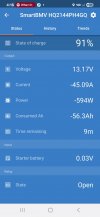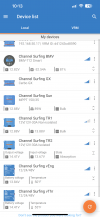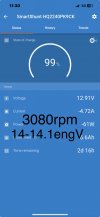profcbutler
Active member
- Joined
- Feb 16, 2024
- Messages
- 27
- Location
- North East Maryland
- Fluid Motion Model
- R-25 (Outboard)
- Hull Identification Number
- FMLT2506G425
- Vessel Name
- TUG-GETHER
This past month I took possession of my new 2025 Ranger Tug R25. This has been one of the best customer experience I have ever had with a major purchase. I can't say enough about the entire support team at Pocket Yachts in Grasonville!
I am posting this question on Tugnuts to see if anyone has gone down the road I am looking to take.
I am lucky enough to have purchased the R25 at a time when they were offering a powerful lithium configuration. I have the luxury edition with 600 amp hours on the house battery bank. I have already seen the value of this when I take the boat out for hours and run the AC. It seems I could be out for days without having to hook back up to shore power. Although, I am incredibly happy everything seems to be working properly, I am limited to what I can see as it relates to the individual components of the electrical charging system.
I have the BMV-712 Smart Battery Monitor to provide me very basic information. However, it is very limited (see attached Pic)
Has anyone updated a 2025 Ranger tug with a more detailed charge monitor? What i would love to see is the health of the Engine, thruster, and house battery with how effective each piece of the charging system actual is (Engine, Shore, and Solar). I have seen this type of monitor on larger boats and RV's (i.e. Victron Energy GX touch). It clearly shows all parts of the system and how the pieces are performing with the ultimate goal of charging the battery(s). I know Ranger did not install all Victron pieces when building the system. I am sure they all integrate well but not so sure it can be upgraded to support a better monitor. Looking at simple functions like... how well the solar panel is charging. I know the Victron GX display does this but not sure it would work in the current factory configuration without a major overhaul.
Does anyone have any experience with this? I do not want to build a whole new system... Just looking for a simple solution to tap into the existing structure to get a better view of all the pieces. Hope this all makes sense.
I am posting this question on Tugnuts to see if anyone has gone down the road I am looking to take.
I am lucky enough to have purchased the R25 at a time when they were offering a powerful lithium configuration. I have the luxury edition with 600 amp hours on the house battery bank. I have already seen the value of this when I take the boat out for hours and run the AC. It seems I could be out for days without having to hook back up to shore power. Although, I am incredibly happy everything seems to be working properly, I am limited to what I can see as it relates to the individual components of the electrical charging system.
I have the BMV-712 Smart Battery Monitor to provide me very basic information. However, it is very limited (see attached Pic)
Has anyone updated a 2025 Ranger tug with a more detailed charge monitor? What i would love to see is the health of the Engine, thruster, and house battery with how effective each piece of the charging system actual is (Engine, Shore, and Solar). I have seen this type of monitor on larger boats and RV's (i.e. Victron Energy GX touch). It clearly shows all parts of the system and how the pieces are performing with the ultimate goal of charging the battery(s). I know Ranger did not install all Victron pieces when building the system. I am sure they all integrate well but not so sure it can be upgraded to support a better monitor. Looking at simple functions like... how well the solar panel is charging. I know the Victron GX display does this but not sure it would work in the current factory configuration without a major overhaul.
Does anyone have any experience with this? I do not want to build a whole new system... Just looking for a simple solution to tap into the existing structure to get a better view of all the pieces. Hope this all makes sense.
Attachments
Last edited:





